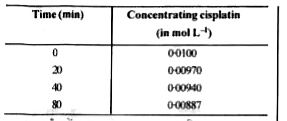स्थिर आयतन पर N2O5(g) के प्रथम कोटि के ऊष्मीय वियोजन पर निम्न आँकड़े प्राप्त हुए
2N2O5(g)→2N2O4(g)+O2(g)
क्र०सं०समय/sकुल दाब/atm100.521000.512
वेग स्थारंक की गणना कीजिए ॥
N2O5 के ऊष्मीय वियोजन को निम्न रूप में लिख सकते हैं ।
2N2O(g)→2N2O4(g)+O2(g)
(t=0,0.5atm,0atm.0atm),(t=t,(0.5−2x)atm,2xatm,xatm)
∴pi=(0.5−2x+2x+x)atm=(0.5+x)atm
∴x=(pi−0.5)
PN2O5=(0.5−2x+2x+x)atm=(0.5+x)atm
∴x=(pi−0.5)
pN2O5=(0.5−2x)={0.5−2(p1−0.5)}
=0.5−2p1+1=(1.5−2p1)
दिया हुआ है कि-
t=100s तो p1=0.512atm
pt=0.512 बैठाने पर
PN2O5=(1.5−2×0.512)atm
=(1.5−1.024)atm=0.476atm
∵k=(2.303)100log(0.5)0.476
=2.303100×0.0216=4.98×10−4s−1
Topper's Solved these Questions
- रासायनिक बलगतिकीBOOK - STUDENTS FRIENDSCHAPTER - रासायनिक बलगतिकीEXERCISE - हल प्रश्न
21 Videos
- रासायनिक बलगतिकीBOOK - STUDENTS FRIENDSCHAPTER - रासायनिक बलगतिकीEXERCISE - अभ्यास प्रश्न (अतिलघु उत्तरीय प्रश्न [1 Mark])
22 Videos
- पृष्ट रसायन BOOK - STUDENTS FRIENDSCHAPTER - पृष्ट रसायन EXERCISE - अभ्यास प्रश्न (रिक्त स्थानों की पूर्ति करें )
7 Videos
- विलयनBOOK - STUDENTS FRIENDSCHAPTER - विलयनEXERCISE - COMPETITION KET (वस्तुनिष्ठ प्रश्न )
60 Videos
Similar Questions
सिसप्लैटिन, जल से अभिक्रिया कर Cl− आयन प्रदान करता है-
[Pt(NH3)2Cl2]+H2O→[Pt(NH3)2H2Ocl]−+Cl− cisplatin
विभिन्न समय अन्तराल में सिसप्लैटिन के सान्द्रण से सम्बन्धित आँकड़े नीचे दिए गए हैं-

इन आँकड़ों का उपयोग कर t1=20 मिनट तथा t2=40 मिनट के बीच सिसप्लैटिन तथा H2O की अभिक्रिया दर ज्ञात करें ।
View Solutionअभिक्रिया वेग से आप क्या समझते हैं ?
View Solutionकिसी ठोस या द्रव के पृष्ठ पर सम्पर्क में आनेवाले पदार्थो के सान्द्रण की घटना को .......... कहा जाता है।
View Solutionवाष्प का अवनमन विलयन के परासरणी दाब के -
View SolutionFor the decomposition of N_(2)O_(5)((g)) , it is given that: 2N_(2)O_(5g)rarr 4NO_(2(g))+O_(2(g)) , Activation energy E'_(a) then , E_(a), N_(2)O_(5(g))rarr 2NO_(2(g))+1//2O_(2(g)) , Activation energy E_(a)^(') then:
View SolutionThe reaction
2N2O5(g)→4NO2(g)+O2(g)
is found to be firt order with respect to N2O5(g). Which of the following is correct ?
View SolutionConsider folllowing reaction at 300 K : N_(2)O_(5)(g)hArrN_(2)O_(5)(g)+O_(2)(g) K_(c)=5 N_(2)O_(5)(g)hArrN_(2)O(g)+O_(2)(g) If 4 moles N_(2)O_(5) is kept in 1 L, Container to attain equilibrium and at equilibrium 5 moles of O_(2) are produced, then at equilibrium 5 moles of O_(2) are produced, then at equilibrium moles of N_(2)O_(3) will be :
View SolutionFor the first order reaction 2 N_(2)O_(5)(g) to 4 NO_(2) (g) + O_(2)(g)
View SolutionConsider the reaction 2N_(2) O_(5(g) ) to 4NO_(2(g)) +O_(2(g)) in liquid bromine If --(d[N_(2)O_(5) ])/(dt)=0.02 M s^(-1) then NO_(2) is formed at _______.
View SolutionThe following data were obtained during the first order thermal decomposition of N_(2)O_(5) (g) at constant volume: 2N_(2)O_(5)(g) to 2N_(2)O_(4)(g) + O_(2)(g) {:("S.no","Time", "Total Pressure / atm"),(1,0,0,5),(2,100,0.512):} Calculate the rate constant.
View SolutionFor a first order reaction involving decomposition of N_(2) O_(5) the following information is available : 2N_(2)O_(5)(g) rarr 4NO_(2) (g) +O_(2)(g) Rate =k [N_(2)O_(5)] N_(2)O_(5)(g) rarr 2NO_(2)(g) +1//2 O_(2) (g) Rate =k [N_(2)O_(5)) Which of the following expressions is true ?
View SolutionFor a reaction, 2N2O5(g)→4NO2(g)+O2(g) rate of reaction is:
View SolutionConsider the reaction 2N_(2) O_(5(g) ) to 4NO_(2(g)) +O_(2(g)) in liquid bromine If -(d[N_(2)O_(5) ])/(dt)=0.02 M s^(-1) then NO_(2) is formed at _______.
View SolutionIn the decompoistion of N2O5(g),
2N2O5(g)kobs−−→4NO2(g)+O2(g),
the observed rate law is given by
d[O2]dt=kobs[N2O5].
Which of the following proposed mechanics is conisstent with the rate law?
a. N2O5(g)k−−→N2O3(g)+O2(g)
b. N2(g)+NO3(g)k1−−→NO(g)+NO2(g)+O2(g)
View SolutionFor the first order reaction
2N2O5(g)→4NO2(g)+O2(g)
View SolutionThe order for the reaction given below is ......... .
N2O5(g)⇔N2O4(g)+12O2(g)
View Solution